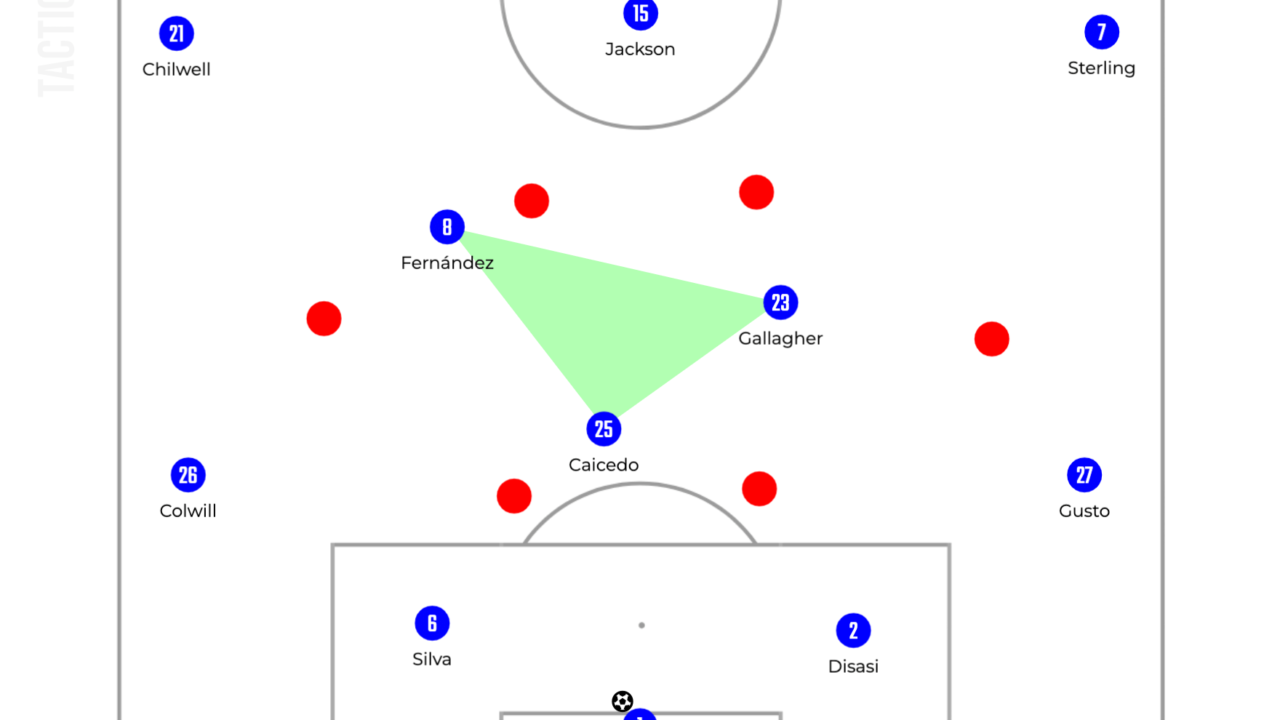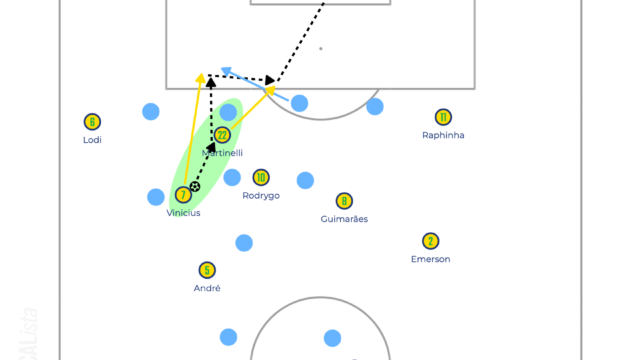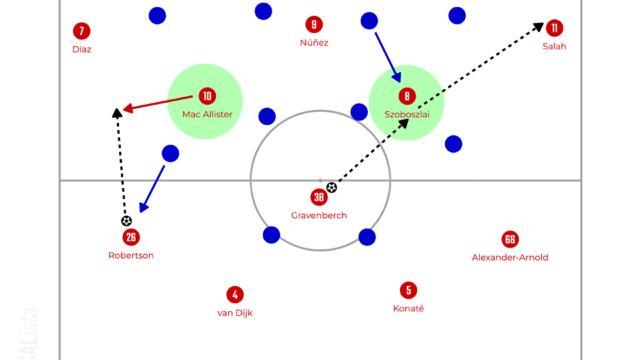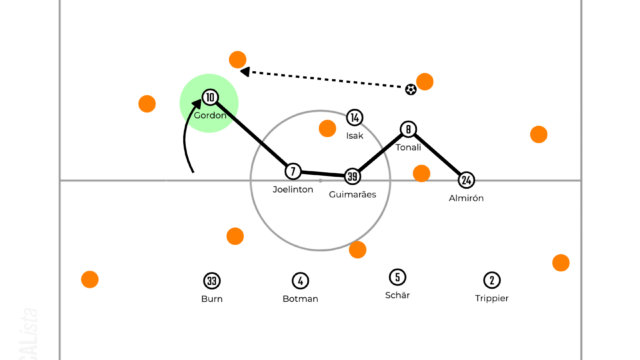Why Does Mauricio Pochettino’s Side Struggle with Scoring Goals? [Chelsea Tactical Analysis 23-24]

Overall
Chelsea is still looking for their form after the change of the owner of the club. Many new signings have been made and many players has left. The drastic changes in the club always need to sacrifice for the points, and it has continued this season. However, looking at the performance on the pitch or some stats, they are not in the position where they deserve to be. Of course, the performance or stats do not matter if they win or lose a single game, but the performance is important for the results in the future.
One of their problems right now is the lack of goals as they only scored two goals in the five games except for their only win against Luton Town by 3-0 and they currently scored no goals in three games in a row (vs Nottingham Forest 0-1, vs Bournemouth 0-0 and vs Aston Villa 0-1). This is the most crucial matter because they need to score to win the game. Additionally, they are not bad out of possession, with only conceding three goals in the five games except for the game against West Ham, which they lost by 3-1, so if they could score at least a goal, the results were not same. Therefore, the lack of goals is the most important issue for Pochettino’s side right now.
In this article, the tactics of Pochettino at Chelsea are going to be discussed in detail and the reason of their lack of goals is going to be explained based on their first six league games.

Build up
When playing out from the back, their aim is finding a spare player in the opposite side by switching the ball and progressing forwards as a team. Except for the first game against Liverpool, which they had a clear aim to exploit their weakness, they prefer to play with a back four. Even though the midfield shape is flexible, the three attackers up front hardly changes.

Let’s talk about the flexibility in the midfield, which is one of Chelsea’s main features in possession. Since Moisés Caicedo started play as a single pivot, the movements of both 8s became more important. Conor Gallagher, who started to play as a single pivot against Liverpool often drops next Caicedo. On the other hand, Enzo Fernández prefers to stay higher and plays like a 10, but he is also good at dropping back to offer a passing lane for the centre back on the ball. This combination of three different types of midfielders is classic but has worked so well to help Chelsea to dominate the midfield.
As it was mentioned earlier, their aim is finding a spare player by switching the ball. This objective is achieved by playing to one of the defensive midfielders who drops back to receive and switches it to the opposite side centre back or fullback depending on the situation.

Especially, the right centre back Axel Disasi is good at driving forwards and playing a split pass, so he is the leader to progress the ball as a team from the back. Additionally, Fernández can find the opposite fullback when the opposition winger marks Disasi, so playing through in the left side and switching the ball to the right side is one of their main options to play out from the back.
Another way is finding Fernández in between the lines. As it was introduced about the flexibility in the midfield earlier, Fernández plays like a 10 frequently. It means not only just staying higher in between the lines but also drifting towards the ball side to create an overload. The best example would be the game against Nottingham Forest.

In this case, by moving across the pitch, Fernández could receive the ball behind the opposition left defensive midfielder who followed Gallagher. His ability to find a space to receive the ball in between the lines is great and he can position himself in the position where the opposition midfielders cannot mark easily. Additionally, it is a trigger for the attackers to make runs in behind when he receives the ball in between the lines.

As a team, Chelsea look for options to use the space in behind especially in wide areas. Therefore, it is sometimes seen that one of the centre backs, especially Thiago Silva, plays in behind to find a winger running in behind. Even though their aim is progressing as a team by finding either of the opposite side centre back or fullback, if they can play through the opposition midfield line and find Fernández, the attackers up front make a sprint in behind. Nicolas Jackson is very good at finding the timing to run in behind to break the opposition back line as soon as someone faces forwards with the ball in between the lines.
In the midfield, thanks to the ability of Disasi to drive forwards, the right flank is their main area to play. The relationship between Raheem Sterling and Malo Gusto is extremely good and they create and use space each other. Usually, Sterling keeps the width and pin the opposition fullback, providing the space for Gusto to step in after receiving the ball.

Additionally, Sterling sometimes narrows in to drag the opposition fullback inside, leaving the flank clear for Gusto to go forwards. Overall, they can create a 2v1 constantly in the right side and progress the ball into the final third.
Final Third Attacking
In the final third, their first choice is exploiting the space in behind in wide areas and delivering low and fast crosses quickly. As it was explained in the previous chapter, both wingers make a run in behind frequently to break the opposition back line. In addition to the wingers, the right fullback Gusto is so aggressive and when Sterling comes inside, he overlaps and tries to receive the ball in behind. Then, as soon as receiving the ball, they cross the ball into the box, which is often a cut back.
Thanks to the presence of Jackson in the middle and his movement towards the goal, the opposition back line quickly drops back to close the space between the defenders and goalkeeper. Jackson tapped in Sterling’s cross delivered to the dangerous area between the opposition defenders and goalkeeper against Luton and this is what the opposition defenders prioritise to defend. However, this often leaves the space in front of the back line and this area can be used by cut backs.

If they delay delivering cut backs, the opposition defensive midfielders can come back to protect the space in front of the back line, so the crosses need to be delivered quickly.
When they face a deep defensive block, they still try to exploit the space in wide areas and the structure is similar to build up. Disasi steps forwards in the right side and Sterling and Gusto are flexible and frequently swap each lane to attack dynamically. Additionally, Fernández moves across the pitch to create an overload in the right side and he also often makes a run into the channel.

In addition to the structure, Sterling makes a difference by taking on the opposition fullback and penetrating into the box individually. This is simple, but one of the biggest threats of Chelsea. In the first four games, Ben Chilwell has played as a left winger, but he only could run in behind and lacked the individual ability as a winger. In the last two games, however, Mykhailo Mudryk started as a left winger and will possibly become another threat in the left flank, which can help Chelsea to create more chances.
Even though they have lacked the threats from the left side, they have an option to play through in the middle with Jackson running in behind. They have many options and it looks like just being clinical in the box is what Chelsea need right now, and it is true to an extent, but the possible reason why they cannot score more goals is the lack of efforts to disorganise the opposition centre backs.
It is extremely important to disrupt the opposition centre backs to create bigger space in the box and better opportunities. They try to exploit the wide areas, but the opposition centre backs can stay in the middle and deal with crosses. Even though they try to deliver cut backs to exploit the space in front of the back line, the shot from cut backs can be blocked by the opposition centre backs. Moreover, even crosses can be intercepted and cleared by one of the opposition centre backs because they can keep positioning themselves in proper area. Therefore, it is important to disorganise the opposition centre backs.
To disorganise the opposition centre backs, it is important for the attacking midfielders or wingers to receive the ball and face forwards in between the lines. This can create a 2v1 situation against one of the opposition centre backs with the striker, Jackson. Fernández can receive the ball in between the lines, but he often releases the ball before dragging one of the opposition centre backs out. This is just an example, but Chelsea can mainly play in wide areas and it is easy for the opposition centre backs to stay in the middle. Therefore, attacking more centrally can be one of the solutions, but to be fair, they need to be more clinical.
Pressing
Their basic system is a 4-1-4-1, but the players up front prioritise to mark the opposition players rather than keeping the shape, so it looks like two strikers or back five. One of the midfielders, especially Fernández steps up into the first line and the left winger Chilwell often followed the opposition fullback and dropped into the back line.
The pressing trigger is the pass to one of the centre backs from the goalkeeper and Jackson makes a curved run to show the centre back outside.

The attacking midfielders or sometimes even Caicedo prefer to mark the opposition defensive midfielders tightly to prevent them from playing through. However, in the first five games, the wingers tend to drop deeper to mark the opposition fullbacks. Therefore, if the opposition can manage to switch the ball to the opposite side centre back by using the defensive midfielder, the pressing is escaped.

The attacking midfielder can jump to the opposition centre back, but there is an underload up front anyway, so the pressing is often slowed by the opposition build up. This can be one of their weaknesses when pressing, and it reduced the chance of winning the ball up front to play counterattacks. Counterattacks are great opportunities to score goals, so the defective pressing might also cause the lack of goals.
However, after the international break, the pressing has been improved. In the first four games with Chilwell as a left winger, he often stayed deeper and lacked the aggression to jump to the opposition centre back. On the other hand, Mudryk stepped up to press the opposition centre back against Aston Villa, which is the first game after the break. They became more aggressive and improved the pressing, so this can be a solution to score goals from counterattacks.
Final Third Defending
When defending deeper, the attacking midfielder stays higher and the system becomes a 4-4-1-1. And as it was mentioned, they are not bad to defend the goal and most goals conceded came from counterattacks.
Similar to the pressing, the wingers tended to be deeper and drop into the back line, which makes the shape a back five. However, this has also been changed after the international break. Both wingers stayed higher and kept the midfield line of four and also this will help playing counterattacks.
These days, most teams defend with all 10 outfield players in the own half. However, Pochettino prefers to keep Jackson higher to play long counterattacks.

As soon as winning the ball back, playing to Jackson is the first option to play a counterattack. In addition to this, both wingers make a forwards run to support Jackson and create an overload against the opposition back line. Again, this can also be another resource of scoring goals. Therefore, this option will be extremely important for Chelsea.
Overall, it is a fact that Chelsea could only win once while lost three time in their first six league. However, there was an international break after the five games and they showed an improvement after the break, although they lost against Aston Villa by 1-0 after Gusto was sent off. The performance is brilliant, they are on the way of improvements. Thank you for reading.


